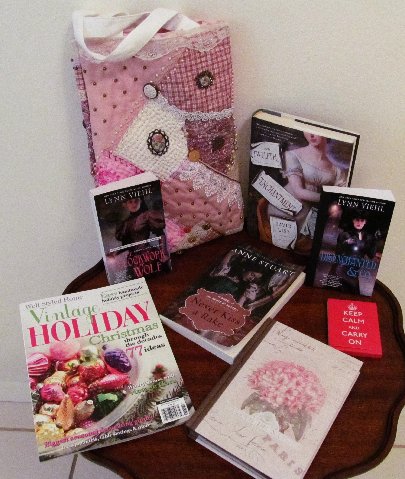 You are never more Victorian than when you celebrate Christmas, and this is because a great many of today’s holiday traditions began or were popularized during the Victorian era.
You are never more Victorian than when you celebrate Christmas, and this is because a great many of today’s holiday traditions began or were popularized during the Victorian era.
Decorating a Christmas tree, for example, was originally a somewhat obscure German tradition dating back to the sixteenth century. Yet when Queen Victoria married Prince Albert, who was born in Germany, she also adopted many of his homeland traditions for the royal family’s holiday celebrations. This included the setting up and decorating of a tannenbaum at Windsor Castle. Since Her Majesty was regarded by her subjects as the ultimate social trend-setter, the custom spread like wildfire, until nearly every household in England put up and decorated their own tree during Christmas. Today it’s estimated that 25 to 30 million Christmas trees are sold each year during the holidays.
When you give gifts during Christmas and place them under your tree you’re also being quite Victorian. According to the original German practice, little gifts were sometimes tied to or hung from the branches of the Christmas tree, a custom which the Victorians found especially charming (and until this era midwinter gift-giving was usually done on New Year’s Day, but moved to Christmas as that became the more popular holiday among Victorians.) As with most things, the Victorians liked to go bigger and more elaborate, and soon the gifts they bought each other were too big and too many for the tree’s branches, so they began placing them under the tree.
Hand-written cards and letters were very important during the Victorian era, as correspondence was the primary form of personal communication. You may have even felt a pang of regret when reading a Victorian-era novel during which one of the characters sits down at a desk to write, or reacts to some important news delivered by letter. Still, every time you send a Christmas card to someone you’re doing almost the same thing.
Our habit of sending cards to each other during Christmas was born in 1843, when Sir Henry Cole had artist John Calcott Horsley design and print for him a thousand cards depicting a Christmas scene. According to some researchers, Cole chose to go with cards because he didn’t have time to write his annual holiday letters to his friends and family; others claim he commissioned the cards to sell in his London art shop.
Either way, at a cost of one shilling a pop, Cole’s Christmas cards were too expensive for most people to afford, but the concept appealed to many Victorians, who began hand-making their own cards (this apparently includes the Queen, as there exists some evidence that her own children made Christmas cards.) It would be another twenty years before printing technology and mass production advanced enough to make printed Christmas cards inexpensive, but by then the custom of sending cards had become another lasting tradition.
Some of the carols you sing during Christmas hail from the Victorian era (Joy to the World, 1833; O Come All Ye Faithful, 1843; Jingle Bells, 1847; We Three Kings, 1857; O Little Town of Bethlehem, 1868; and Away in a Manger, 1883.) Caroling wasn’t invented by the Victorians, but they were huge fans of musical entertainment and did much to revive the practice. There were no radios or recordings at the time, so if you wanted music you had sing or play your own instruments. Many Victorians would often go out caroling door-to-door during the holidays as a family activity in order to spread cheer and entertain their neighbors — probably why the first historically important collection of these songs, Christmas Carols Ancient and Modern, collected by W.B. Sandys, was published in 1833.
Even when you’re being charitable during Christmas, you’re participating in a practice that can in one sense be attributed to the Victorians. For this we have to blame author Charles Dickens, who published A Christmas Carol in 1843. The story, in which a very affluent but stingy businessman is haunted by three Christmas ghosts who convince him to avoid damnation by becoming generous, offered for the time a fairly radical philosophy about charity. Yet the story convinced many wealthy Victorians to begin giving generously to the poor and needy during the holidays. To me what Dickens did with his book is probably the finest of all Victorian Christmas traditions, for it continues to inspire us to do the same during the holidays — and is there any better way to celebrate the season of giving?
The giveaway includes:A hand beaded and quilted Victorian toteSigned print ARCs of Disenchanted & Co. and The Clockwork WolfUnsigned copies of The 12th Enchantment by David Liss and Never Kiss a Rake by Anne StuartA pretty Victorian-style journalA Keep Calm and Carry On notepadA copy of Vintage Holiday Christmas magazine


Interesting info about cards
bn100candg at hotmail dot com
I always thought Christmas cards were a 20th-century custom, bn, so it surprised me too.
lovely post! And go for those goodies. I’m fortunate enough to have something Lynn made and it’s exquisite!
Thanks for the kind words, Lynne (and I’ll take this opportunity to mention that the giveaway is open to everyone, so residents outside the U.S. are welcome to join in.)
Well worth watching the UK series Victorian Farm, which is on PBS a lot, for their take on Christmas. Really interesting stuff!
I had no idea so many holiday traditions started during the Victorian era. The Christmas tree is my personal favorite
How interesting! I don’t miss doing holiday cards, my handwriting has become atrocious!
I’ll second that, Samantha — and BBC also has a neat archive of things you can do during the holidays from the Victorian Farm series at http://www.bbc.co.uk/victorianchristmas/archive.shtml
I like that Queen Victoria adopted the German tradition as a way of celebrating her husband’s roots, Diane — very romantic. 🙂
Many of my online friends send e-card greetings these days, Michelle, and they can be just as wonderful (plus no handwriting required!)
My grandson and his mom watch all the different versions of a Christmas Carol.
Lovely traditions.
Thanks for the info on Christmas cards. I love the look of Victorian cards.
Joyce, there are so many retellings of Dickens’ book they must number in the hundreds by now. I think my personal favorite version was the film Bill Murray starred in, back in the late 80’s — very contemporary and funny but still very true to the story.
They are lovely, Robin, but then most old-fashioned things are. 🙂
Sandy, I’ve been discovering Victorian-era scrapbooks lately, and in many of them Christmas cards were saved because of the gorgeous artwork.
I enjoyed learning about these Victorian traditions which we follow every year.
What an interesting and informative Victorian post which was captivating. Merry Christmas and best wishes.
Dickens was influenced to be giving due to his own experience. I enjoyed this unique post.
Thank you, Anne, for taking the time to stop in and catch the post. 🙂
Merry Christmas to you, too, Ellie.
Diane, I was just reading in Judy Reeves’s A Writer’s Book of Days (great book, btw) that Dickens walked twenty to thirty miles every day. To give you a comparison, one current-day study I read estimated most adults walk between 1-1/2 to 5 miles per day. (Naturally if they are active and/or athletic they can log more distance; I personally walk between 4 and 7 miles a day.)
Love the history and so much of it unknown
Researching the Victorian era for my series is a bit like a treasure hunt, Robin — I never know what I might find in the chronicles of history that I can use in my fiction. 🙂
I am logging off for the night, but I’ll stop in tomorrow morning to chat with you all again. Thanks to Sandy and everyone at TGTBTU for having me as a guest today, and happy holidays to you all!
Thanks for chatting, Lynn. My utter favourite Christmas tradition is advent calendars. I always download an animated one onto my computer, but this year I don’t have a physical one for some reason.
I knew about most of this but it still made interesting reading. What a shame Christmas has now been hacked by commercialism and starts, especially here in the UK, almost before Halloween! You get sick of Christmas by the time it gets here. I wonder if its any different on your side of the pond?
Super post. We make tiny tree presents too.
Great post. A lot of great information – love history!
Lynn,
Your research always astounds me! I love all of the information you wrote concerning Christmas traditions. As I am German on my mom’s side of the family, I already knew about the tree, but the cards and other info was great also. Take care!
Tami
Jacksonville
I love this post! Writing notes is one of my favorite things. I also didn’t know that about Christmas trees! I LOVE IT! Thanks for the informative post, I learned some wonderful holiday history.
Advent calendars are a beautiful way to countdown the days until Christmas, Stevie. We have a little Christmas tree music box that has 25 smaller boxes around the base, and every day in December the kids open one box and take out a tiny ornament to place on the tree. 🙂
Unfortunately the commercialization of Christmas starts at the end of September now here, Fran — or at least it did this year. I try to ignore it as much as possible but it can be a bit depressing. To combat it we try to join in as many community celebrations as we can during the month of December; especially those that have no “sales” of anything involved.
Thanks, Rachel (I might adopt the German tradition of placing little gifts on the tree this year. Seems like a fun thing to do.)
History has always been my favorite subject, Marie — it makes writing this series a real treat, too.
Hey, Tami, it’s great to see you here. 🙂 Since half of my family is German-American I loved the research into their traditions. Every time I think I know everything about them I discover something new! 🙂
My pleasure, Jessica. I hope we all do what we can to bring a little more tradition back to the holidays. This year I’ve handmade something for everyone on my list; next year I might try handmaking my cards. 🙂
It was a nice refresher reading about Victorian Christmas customs.
Thanks, Valerie. 🙂
I am heading out to spend some time with my family, but before I take off I’d like to again say thanks to Sandy and the ladies for having me as a guest, and wish everyone a very happy and peaceful holiday season. Good luck with the giveaway!
The info about Sir Henry Cole reminds me I need to get started on my own holiday cards. I just downloaded Judy Reeves’s A Writer’s Book of Days – thanks for mentioning it, and for including a David Liss title in the giveaway since I love his historicals.
What an interestiong post. I don’t think I realized how many traditions came from Victorian times.
Nice article, Lynn. Thank you for all you do!
Of all the Christmas gifts I’ve received over the years, the handmade ones are the ones I treasure the most….
Beautiful bag of goodies, as always. 🙂 It is interesting to realize that what we are trying to achieve when we go for a “vintage” feel with our Christmas decorations is actually a Victorian feel.
I love Christmas cards and traditions. It makes this time of year so memorable.
Great post. It is so interesting how some of our traditions originated in the Victorian era. I have learned alot.